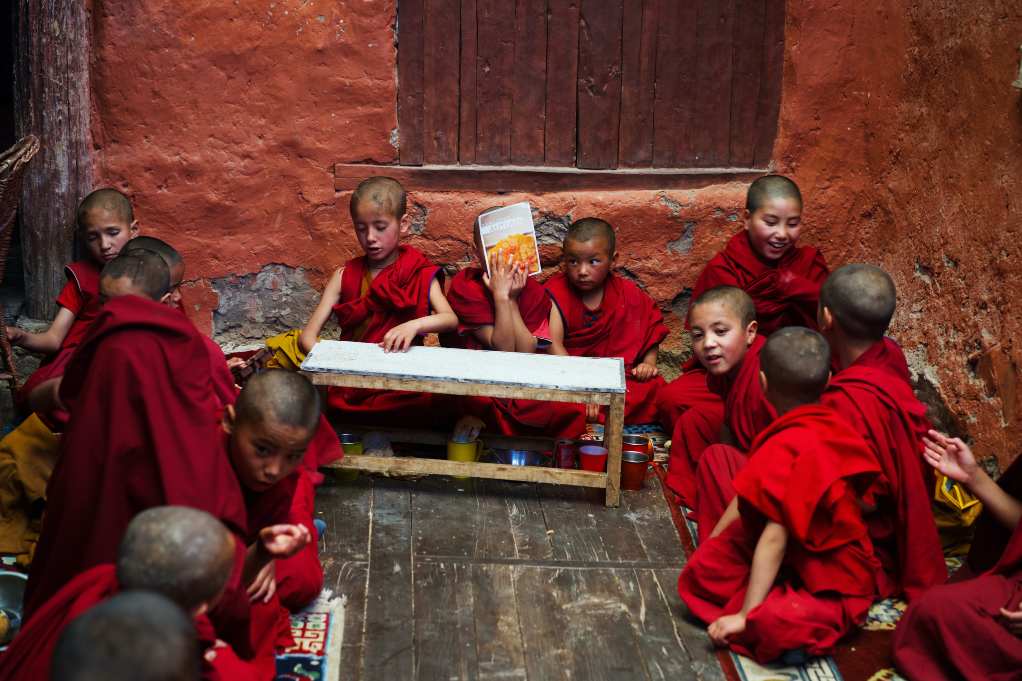Most people in Ladakh are Tibetan Buddhists. The signs of Buddhism are seen everywhere (prayer flags, wheels, and chortens). Ladakh is the only place where Tibetan Buddhism could remain relatively intact till today. The monasteries in Ladakh belong to different monastic orders. They are usually richly decorated with symbols, Bodhisattvas, wrathful deities, and keep valuable scripts. But without basic knowledge, it is hard to understand the complexity of the Ladakhi religion. Tibetan Buddhism is a mystical, complicated spiritual practice combined with secret Tantric exercises. This culture guide to Tibetan Buddhism will give you a better understanding of this religion and the monasteries during your visit to Ladakh.
What is the population and main religion in Ladakh?
As per the census of 2011, 46% of the population of 274.289 are Muslims, 40% are Buddhists, and 12% are Hindus. It means that the number of Muslims now surpasses that of the Buddhists in a traditional Buddhist region. Around Leh, there are more Buddhists, while the Muslim population lives mainly around Kargil.
The best Ladakh and Kashmir itinerary
Spread of Tibetan Buddhism in Ladakh
Buddhism came to Ladakh through India and not Tibet. But later, it got under the influence of Tibet, so they also follow the Mahayana branch of Buddhism. Instead of striving to attain nirvana, they should dedicate their lives to helping other people on the same path. One has to renounce his salvation for the joy of working for the liberation of others. A Bodhisattva does not act for his benefit but for that of others. The center of Tibetan Buddhism is in Lhasa, the Potala Palace.
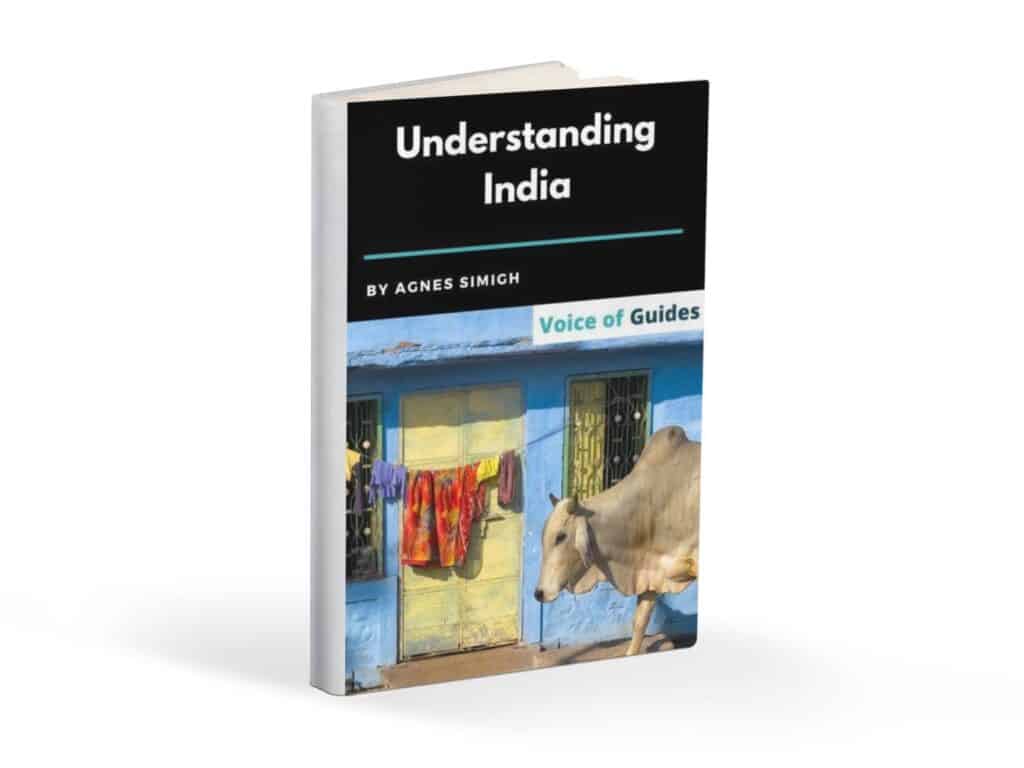
Tibet was able to retain its independence until 1950 when it became a province of China. In 1959, the Dalai Lama had to flee to India. Religion and Tibetan folk costumes were both banned between 1966 and 1979. Since then, under strict rules, they can practice Buddhism.
The ultimate guide for Ladakhi culture
In addition to Mahayana Buddhism, they follow the path of the Vajrayana branch. Ladakh is the only place where Tibetan Buddhism could remain relatively intact till today. There are several reasons for this. First, it is very isolated. Second, it is the only province of Tibet that China did not annex during the invasion of 1950 but remained part of India. Thus, the Buddhist culture in Ladakh did not become the target of the “liberating” Chinese military tanks. In Tibet, they abolished the Tibetan Buddhist religion, saying that it is a superstition and makes people dumb.
Ladakh still keeps Buddhism alive and makes it the only place where they practice the original Tibetan Buddhism.
Pin it for later!
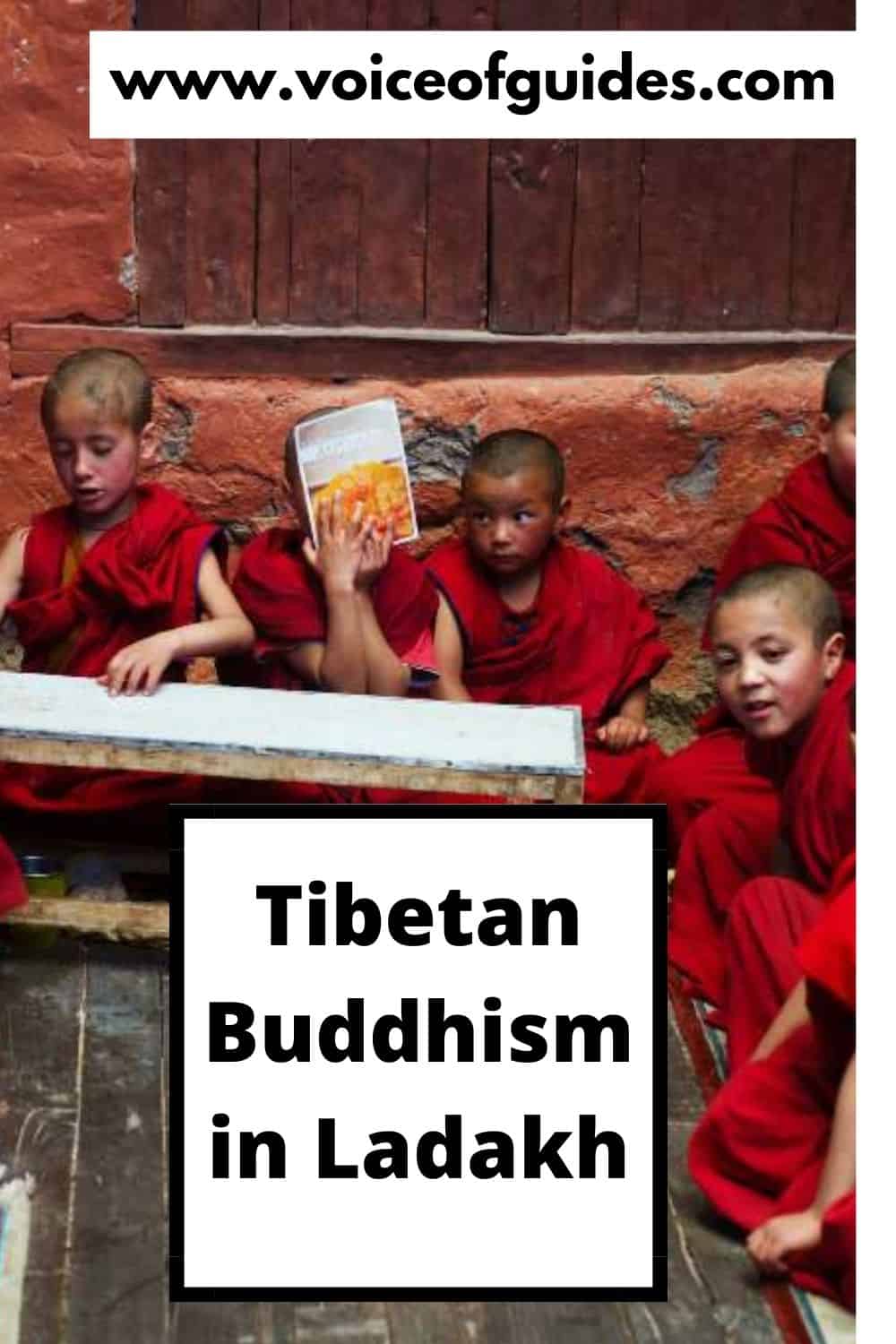
Understand the religion in Ladakh
Colorful Prayer flags
You can see the flags with mantras, prayers, auspicious symbols inscribed on them around monasteries, stupas, and other spiritual places. The colors represent the five elements: fire, air, water, space, and earth. As the wind blows the flags, it will convey the messages to heaven. The use of prayer flags comes from the pre-Buddhist Bon religion, where they used colored pieces of textile with magical texts that have healing effects.
“Om Mani Padme Hum”
“Raise to the Jewel at the heart of the Lotus” – a symbolic expression seen on roadside rocks or the stones of the praying wall. The lotus expresses the universe, and the gem in it is the soul of the World. It means that the Deity shines like the dewdrop in the lotus flower. There are several other mantras, but this is the most popular. This spiritual sentence accompanies the Tibetan Buddhist from birth to death and even beyond until he is reborn. It is the core of Buddhist religion in Ladakh.
The best Ladakh and Kashmir itinerary
Prayer wheel
As you travel around in Ladakh, you see two types of prayer wheels. One is a metal structure that consists of plenty of wheels with Tibetan scripts engraved. While turning the wheels one after the other, they murmur the sacred mantra, “Om Mani Padme Hum.” They can be found around monasteries and temples or just along the streets of villages.
The other type is hand-held and spins around while they are walking. Usually, older men carry that.
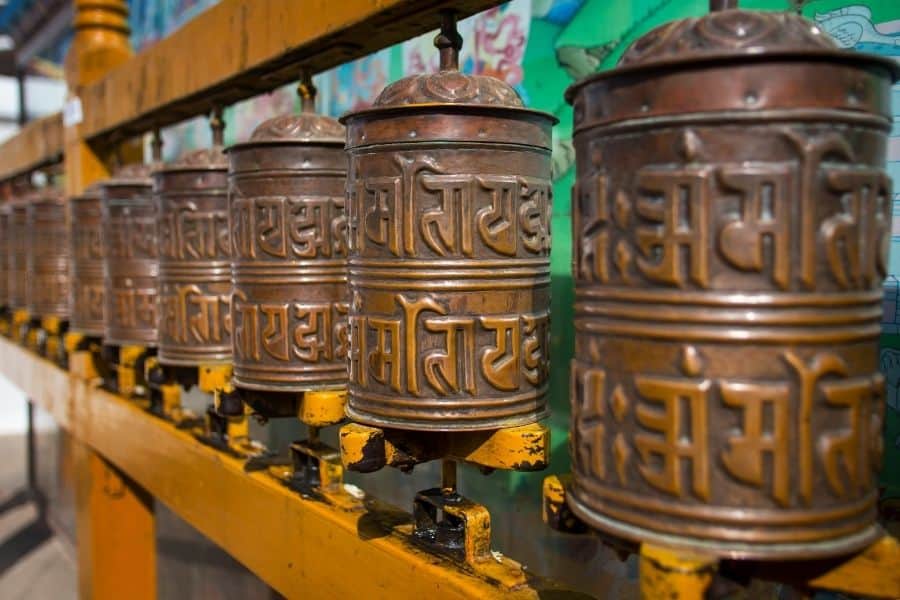
Mani-ringmo (prayer walls)
Mani-ringmo is a long praying wall made of flat stones with Buddhist mantras, most often “Om Mani Padme Hum” written on them located in the neighborhood of monasteries. When pilgrims ascend, they place some stones on top. They always walk past the walls clockwise, with the wall on their right.
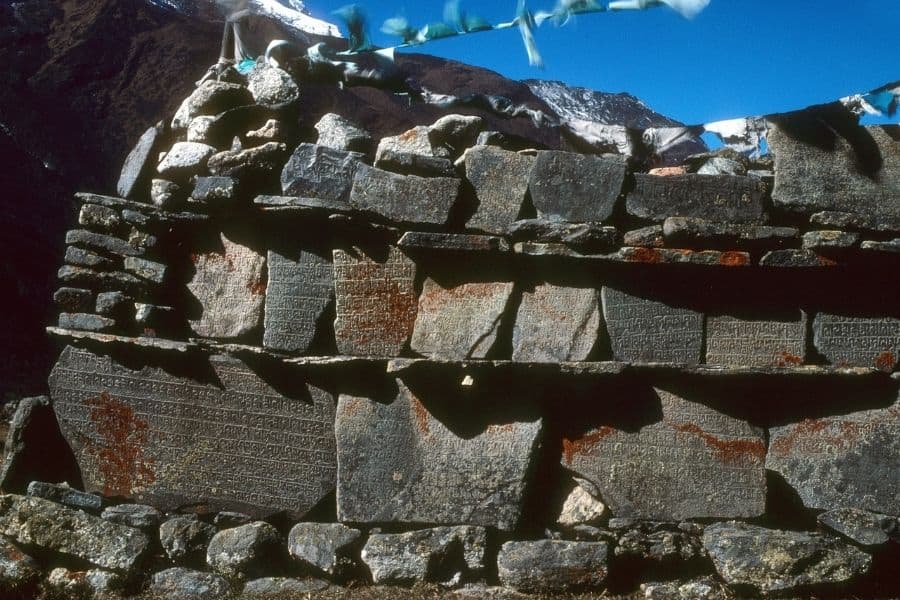
Gompa (monastery)
Gompa is the Tibetan word for monasteries, where monks and nuns live and practice their religion. In Ladakh, it is also where children study to become monks. Gompas always played a central role in the life and economy of the local community. For defense purposes, almost all monasteries cling against the mountain like a fortress. The gompas have no heating in winter. The monks sip hot, salty, yak-butter tea for centuries, as internal heating, with up to dozens of cups a day. Only a few of them have nunneries. The nuns do all the work around the monastery, from cultivation to cooking, so that the monks can concentrate on their spiritual activities. There have been lately some initiatives to improve their circumstances. But nuns still get much fewer opportunities to study religion.
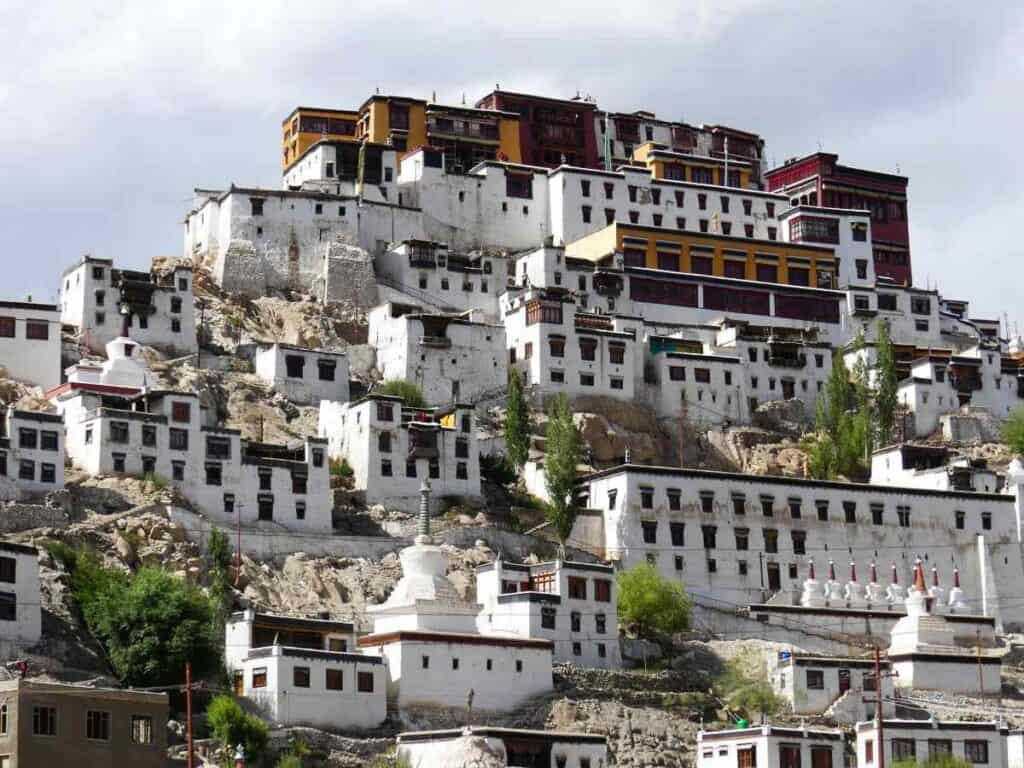
The Dukhang is the main assembly hall of the monastery, where monks collectively come to offer prayer and meditation. The Gonkhang is a smaller chamber devoted to the protecting deities. Women are often not allowed to enter here unless the statues are veiled. The Lhakhang is the temple within a monastery.
The most famous monasteries in Ladakh
Chorten (stupa)
In Ladakh, they use the Tibetan name of the stupa that means chorten. It has a dome-shaped structure on a square pedestal. The spire on top represents the levels towards enlightenment. They are built in memory of a Buddhist monk or religious teacher. Some stupas contain the relics of holy people, or they place very precious things under that, like sacred texts or a Buddha statue. There are plenty of chortens around the monasteries, along the road, or at remote places in the mountain, usually decorated with Buddhist prayer flags.
In the Ladakhi villages, there are chortens of three colors, representing three deities who are the protectors of the villages. The yellow represents Manjushri, the Buddha of wisdom; the white represents Avalokiteshvara, the Buddha of compassion; and the blue, black, or grey chorten represents Vajrapani, the Buddha of power who fights off evil. They are responsible for warding off the evil spirits that could harm the people.
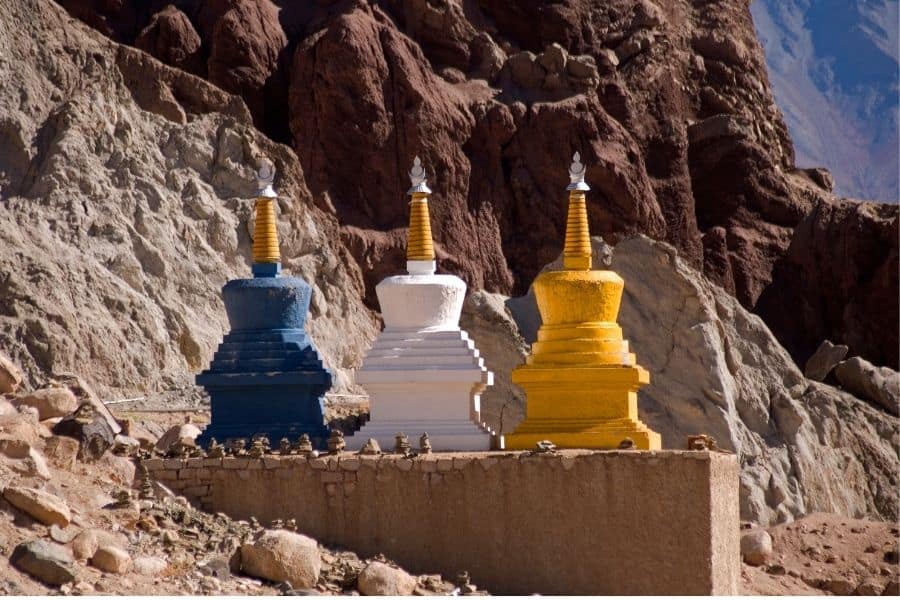
As for their shapes, there are eight types of chortens, each of them symbolizes a life event of Buddha. Plus, each part of the stupa consists of several symbols, including the way to enlightenment, the eight noble paths, or the ten virtues.
The best Ladakh and Kashmir itinerary
Vajras, bells, mandala, and torma
Buddhist monks meditate, perform yoga and tantric spiritual exercises, recite the magical texts and mantras with the help of these tools. Through their ascetic yoga practices, they gain magical capabilities to produce heat, levitate, or bring the dead to life. In general, they can perform supernatural abilities.
The dorje or vajra means thunderbolt.
The vajra is a metal object that is supposed to destroy ignorance. You can see it in many temples along with bells.
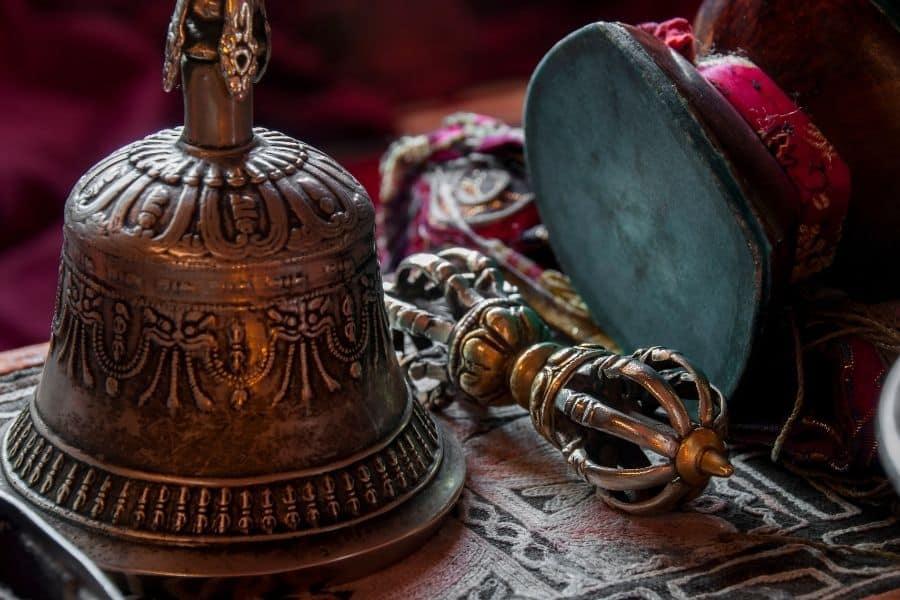
A mandala is usually a circular-shaped geometrical work of art, made of colored sands on the floor, painted on the wall. It helps the monks to concentrate and meditate. The pattern follows old tradition. It takes weeks for a group of monks to make it. At the end of the ceremony, they ritually destroy it, indicating that everything in life is temporary.
Torma is a small figure made of tsampa (roasted barley flour), butter, and sugar. Devotees use it as offerings to the Bodhisattva.
The most famous monasteries in Ladakh
Listen the Amateur Traveler’s podcast about Ladakh and Kashmir, where I share useful tips about traveling there!
The sacred texts of Tibetan Buddhism, the Kangyur and Tangyur
Every monastery keeps a copy of the Kangyur and Tangyur, the sacred texts of Tibetan Buddhism from the 14th century. The Kangyur consists of tantras and sutras that are Buddha’s teachings, while the Tangyur is a series of commentaries on these teachings. Of course, the monks, the great teachers, and lamas have been extending these teachings for centuries. But because of their sacred nature, they did not want to change them.
Thangka
Thangkas are religious paintings made on cotton or silk that are part of the valuable art collection of the monasteries. They usually depict scenes from the life of a Buddha, Boddhisatva, or a mandala. The Thangkas are either hanging on pillars or walls or rolled up. Some of them are several meters long. Monks use them to visually teach the students about the life of Buddha and Bodhisattvas.
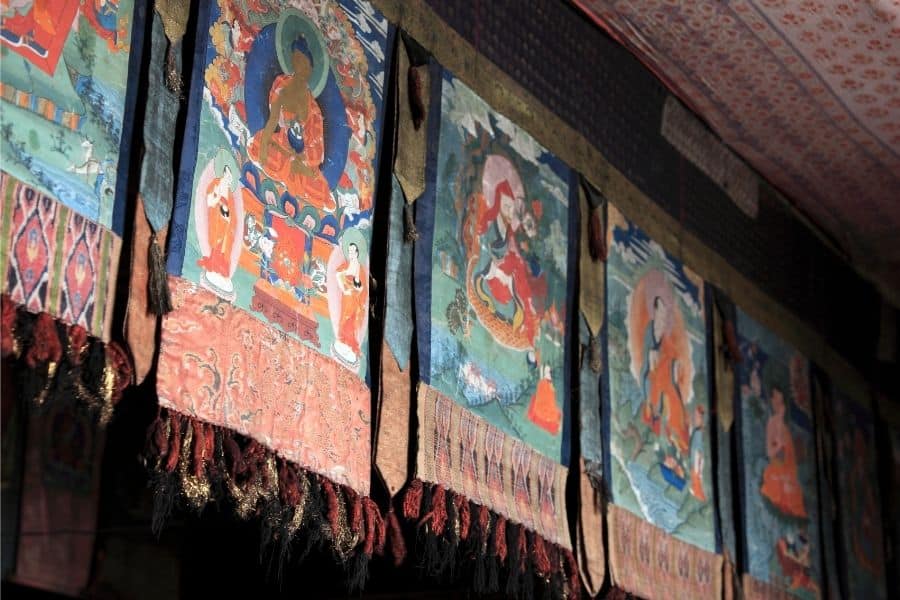
Wheel of Life
The wheel of life often appears at monasteries’ entrances as a wall painting and represents the different aspects of life. The three animals at the center (the pig, the snake, and the bird) biting each other symbolize hatred, ignorance, and greed. The six segments in a circle around depict the realms of different rebirths.
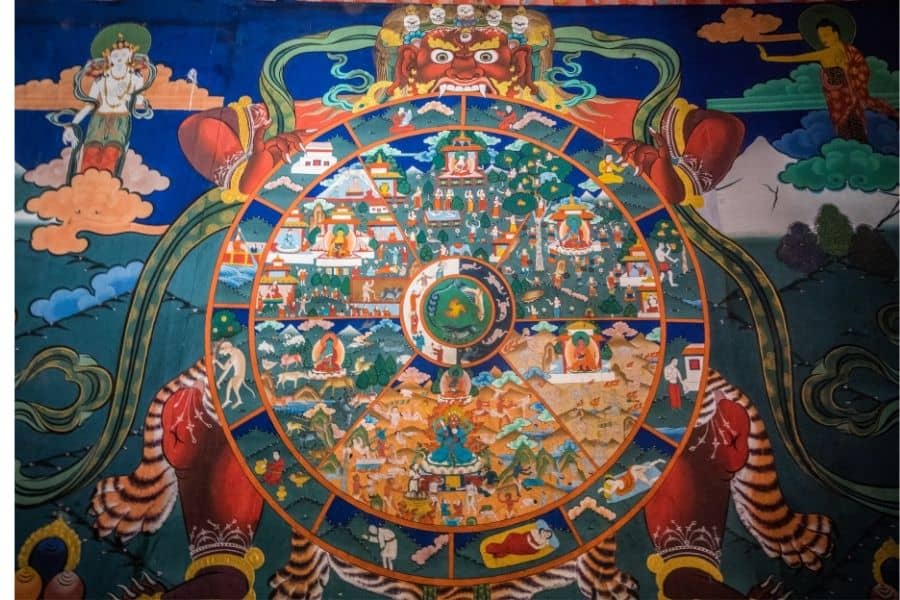
The heavenly realm is at the top and the hellish realm at the bottom. All beings must pass through these various realms. In the outermost circle, twelve further segments illustrate the periods of life from birth to death. The god Yama, the lord of death, holds and even bites the wheel. Buddha is to the right of Yama. He points to a Bodhisattva on the left who can suggest a way out of suffering to nirvana. The wheel of life is one of the most common image of Tibetan Buddhist religion in Ladakh.
The most famous monasteries in Ladakh
The eight auspicious symbols
Each of the eight auspicious symbols manifests a value:
– The umbrella (protection from suffering) represents the head;
– The two golden fish (fortune) represent the eyes;
– The conch shell (the sound of the Dharma reaching far and wide and awakening beings from ignorance) represents the teeth;
– The eternal knot (interweaving and ever-changing spiritual path) represent the waist;
– The vessel (long life and prosperity) represents the neck;
– The wheel (According to tradition, Buddha turned Dharma Wheel when he delivered his first sermon after his enlightenment) represents the feet;
– The victory banner (victory of wisdom over ignorance) represents the whole body;
– The lotus flower (purity and enlightenment) represents the tongue.
The best Ladakh and Kashmir itinerary
Listen the Amateur Traveler’s podcast about Ladakh and Kashmir, where I share useful tips about traveling there!
Cham dances
Almost every monastery in Ladakh celebrates its yearly festivals. Some of them are linked to agricultural seasons, some honor a respected “Rinpoche” (head lama). As part of the celebrations, monks perform spectacular dances in masks. Outside the festival season, these masks hang inside the monastery. This spectacular dance is an integral part of the culture and religion in Ladakh.
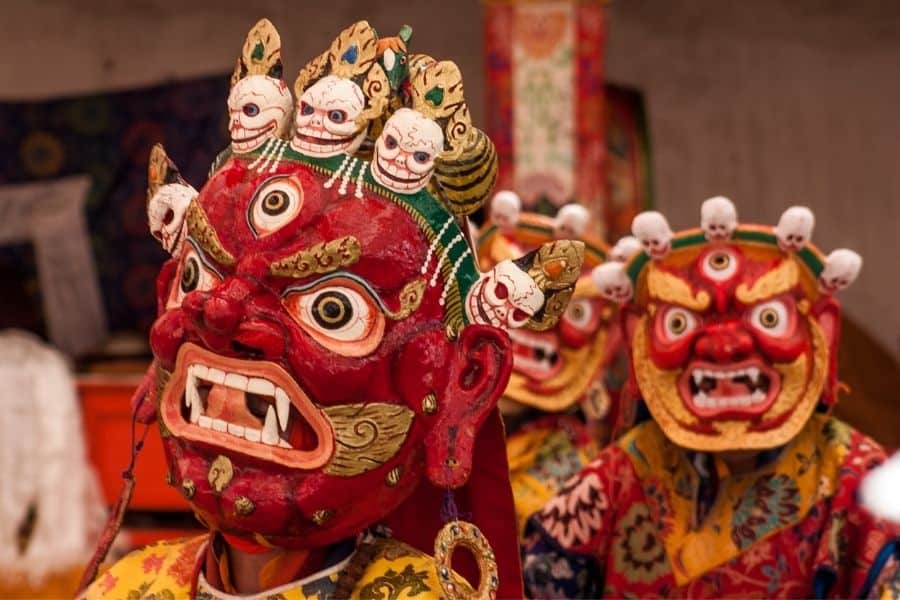
The schools of Tibetan Buddhism
Each monastery follows a Tibetan Buddhist school. It is less the teaching and more the way they transmit the knowledge that makes the difference. There are four principal schools and several sub-schools. They all believe that the best way is to transfer the tradition from mouth to mouth. Therefore, the relationship between the master, guru, lama, and the student is decisive. The Tantric tradition is also crucial to Tibetan Buddhist religion in Ladakh, although monks keep this part a secret. Ritual sexual practices and magic mantras that can influence the weather or prevent diseases are also part of it.
Nyingma
It is the oldest, the first order founded by Padmasambhava, the Indian Tantric sage and magician in the 8th century. Its followers are called the Red Hats Sects. Padmasambhava, later known as Guru Rinpoche, is generally considered the founder of Lamaism in Tibet. The Nyingma sect has a lot in common with the pre-Buddhist Bon religion. It offers a quick path to enlightenment, including sensual and sexual activities.
Kagyü
It is one of the most widespread Tibetan Buddhist sects in the West. According to tradition, experiencing emptiness is a way to enlightenment.
Famous Indian sages, Marpa, Milarepa, Tilopa, Naropa, and Gampopa are the masters of the Kagyü monastic order.
The sect concentrates on meditations, mental and spiritual matters, and above all, to be close to their teachers. It has several subsects: Dagpo, Drigungpa, Drukpa, Taglungpa and the Karmapa.
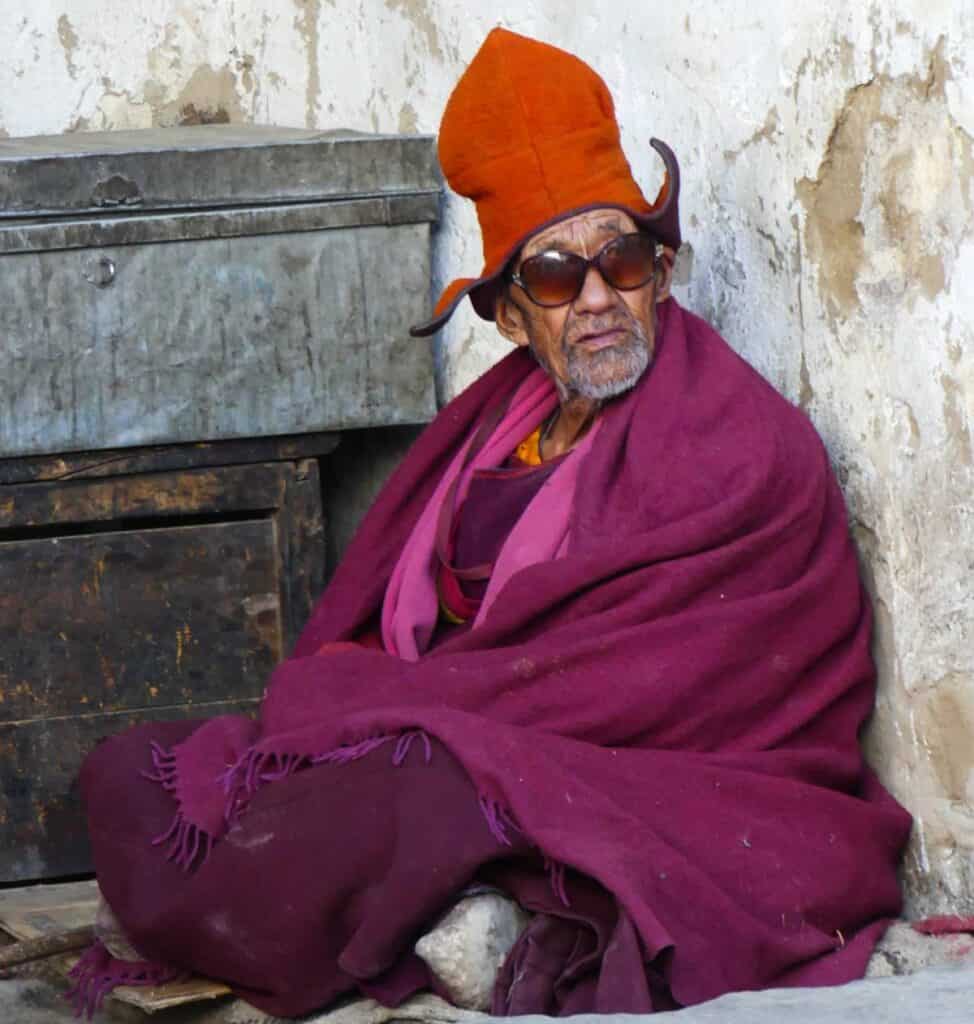
Gelug
The Gelug is the Yellow Hat sect of the Dalai Lama. Tsong Kapa founded it between the 14th and 15th centuries.
He systematically organized the various Buddhist teachings and monastic orders. It was a reformist movement, which applies tantric practices for a better understanding of the Mahayana texts. As of the 1600s, the Gelug lineage of Tibetan Buddhism is the most powerful in Tibet. Its temporary leader is the Dalai Lama, while the Ganden Tripa is the sect’s spiritual head.
The current Dalai Lama had to escape during the Chinese attacks in 1959. Since then, he leads the Tibetan community from Dharamsala. The ganden tripa is not an incarnation of his predecessor but gets elected according to merits for a 7-year-term.
The most famous monasteries in Ladakh
Listen the Amateur Traveler’s podcast about Ladakh and Kashmir, where I share useful tips about traveling there!
Sakyapa
This school embodies the academic tradition. The Sakya Monastery in Tibet is the center of this monastic order. They have their independent tantric traditions only practiced by this line. They attribute high importance to studying the existing Buddhist scriptures and less to the tantric practices. It was the leading school till Tsong Khapa, the next reformer appeared.
Arhat and Bodhisattva
Arhats in Tibetan Buddhism reached a high level of spiritualism but have not attained enlightenment yet. Although, some achieved Buddha-hood.
Bodhisattvas are those who refused to attain nirvana to help others to get on the path. The Bodhisattvas that you will most often see on wall paintings or as statues in the monasteries:
Avalokitesvara is probably the Bodhisattva that you will mostly see in monasteries, who embodies compassion often depicted with 1000 arms.
Manjusri: the Bodhisattva of wisdom, who often carries a sword in his hand, with which he cuts through ignorance and the snare of discrimination.
Maitreya Buddha: The future Buddha, who will once appear as the 5th Buddha.
The Shakyamuni Buddha is the historical Buddha, Siddhartha Gautama Buddha itself.
Tara is a female Bodhisattva who appears as a female Buddha in Tibetan Buddhism. There is Green Tara, White Tara, Red Tara, Black Tara (a symbol of power), Yellow Tara, Blue Tara, etc.
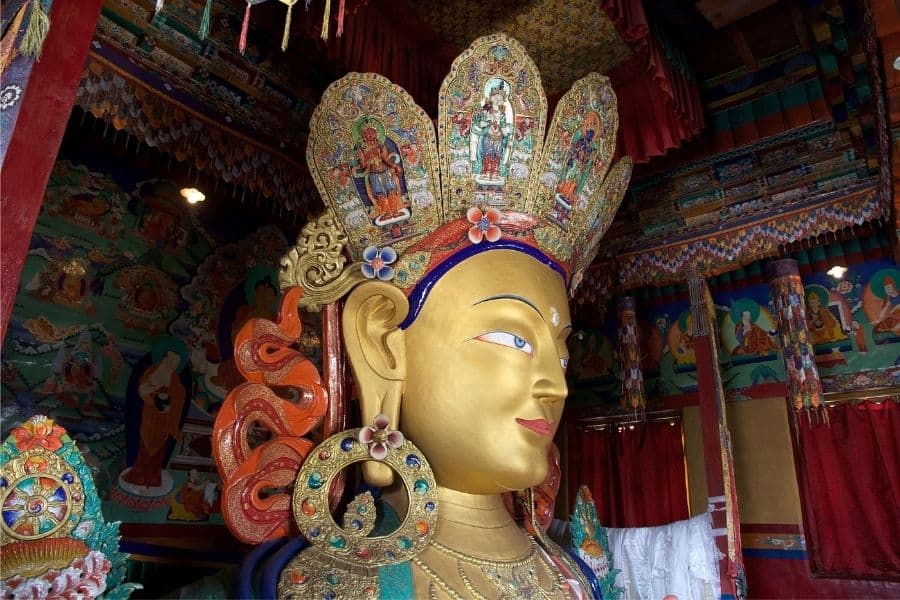
The protectors in Tibetan Buddhism
Often, the wall painting depicts wrathful deities that are another face of a Bodhisattva. They look frightening and demonic, sometimes adorned with human skulls.
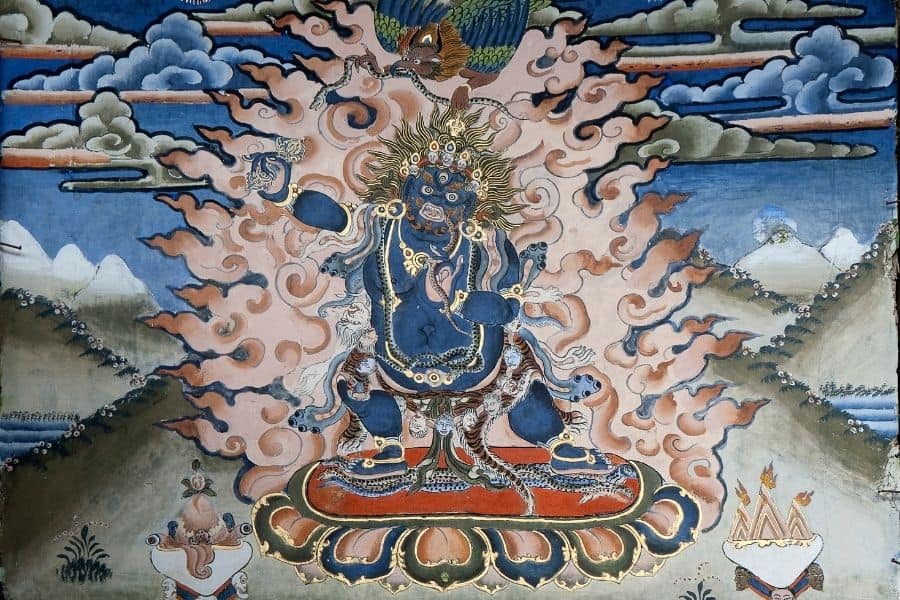
There are Eight Dharmapalas, who are the defenders of Buddhism, and all of them are bodhisattvas. They are supernatural creatures who go into war to protect Buddhism from the enemy. The ones you meet the most often are Jama, the god of death, and Mahakala, the Great Black.
Lokapalas are the guardians of the four directions.
These are essential concepts in Tibetan Buddhism that help you understand more about the significance of structures, symbols, and works of art while visiting the monasteries in Ladakh. I hope you find the above information helpful for your visit to Ladakh.
Useful resources for your travel to India
Insurance: Safetywing insurance that covers COVID-related issues as well.
Train, bus and flight ticket: Book your train ticket at Indian Railways website, or 12Go which gives you the best option (train, bus, and flight) based on the city of departure or arrival.
For your flight ticket use Google Flights.
Accommodation: Booking.com and Hostelworld.com offer a wide choice of low and higher-budget hotels.
Local tours and tour packages: Viator and GetYourGuide offer transfers and several one or multi-day tours.

